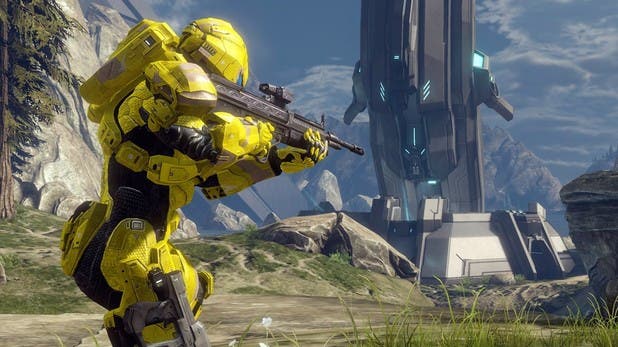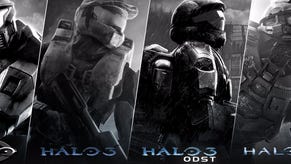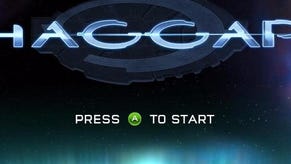Reclaiming Halo's spark
Halo 4's the ultimate in fan service - but is it enough to carry on Bungie's legacy?
What makes a blockbuster game series tick? Sifting through the jaw-dropping vistas of Halo 4, its glorious skyboxes peppered with ceaseless plasma fire, you might think that it's money, and an awful lot of it. The Master Chief's always fancied himself as the centrepiece of a spectacle that's the self-styled 21st century pop-culture alternative to Star Wars. It's only now, though, that the series properly evokes that true blockbuster sensation of subconsciously counting the thousands of pennies thrown at each explosion.
But it's not just money that makes them tick - it's fans, and with Halo 4 that relationship feels more precious, and more important, than ever before. Taking on the legacy left by one of the most widely loved developers was always going to be a near-impossible task. Microsoft has filled the void left by Bungie with an army of talented aficionados and given them a seemingly infinite budget - and the result's perhaps one of the most expensive acts of fan service in history.
That ends up working two ways, of course. There's some feeling that Halo 4 hasn't done quite enough with the formula, that it's taken baby steps rather than being so bold as to leave a big footprint on what is, in many ways, still Bungie's ground. There's some consensus that this is a retread rather than a revolution.

I felt that way myself when I played through an early selection of levels a few months back, walking away content that 343 hadn't ruined the formula but a little disappointed that it hadn't built upon it in any real meaningful way. Having played through the campaign in its entirety, and having been worked through to the early hours several nights over by the multiplayer, I'm now not so sure. In fact, I'm beginning to convince myself that 343's Halo 4 is a more radical game than Bungie would ever have made.
Halo 4 sticks to the core formula, but that's in part through necessity. I love that there's still 13-year-old code here from when Bungie imagined the series as an RTS, just as much as I love that it's still all about that 30 seconds of fun looping over and over. I wasn't expecting to fall quite so much for 343's interpretation of that core, though.
It starts from the Master Chief's boots upwards, before extending to Halo's wider world. The Chief's Spartan armour clanks through the scenery, and is now felt through a visor-like HUD that's been pulled straight from Metroid Prime. While he can still leap like a lamb in low gravity, he now comes crashing down with a metallic thud. John-117's every bit the returning star, and 343 isn't going to let a first person view stop them from making his presence felt in every frame.
It's what the fans want, just as much as they want to be pulling on the triggers of iconic weaponry such as the Battle Rifle, the DMR and the Magnum. 343's done an incredible job of serving Halo's staples, giving them a new bite and snarl that extends to some of the more historically weak weapons. The Plasma Pistol, previously a gun I could never get along with, now feels every bit the equal of the Magnum, firing short angry bursts of plasma that complement its trickier charge function.
Admittedly some of that fan service does ring a little hollow, especially in the open aping of series' highlights in the campaign's set pieces. When a Pelican's handed over to the player's control - a moment that I've been waiting impatiently for since first laying eyes on the machine in Combat Evolved - the giddy rush soon gives way to a slight disappointment that the mission at hand's nothing more than a limp retelling of Reach's New Alexandria.
It's often fan service that's being delivered to the detriment of the wider audience, too. Halo 4's story's a more coherent whole, thanks in no small part to the central human - or, rather, cybernetic - drama that's supplied by the Chief's relationship with Cortana. There are too many holes that can only be filled by reaching out into the wider world of Halo's fiction though, while the decision to hold back key plot points for scenes unlocked by discovering Terminals is an odd move that sabotages the main show.
And some of the explicit additions made by 343 also fall flat. Promethean weaponry never feels anything beyond redundant - even though the Scattershot's been proving my downfall in plenty of Slayer matches - and likewise the Promethean enemy are never quite as engaging as their Covenant counterparts.

They fit neatly enough into that combat loop, though, and it's here that one of 343's more radical changes is felt. The implementation of a sprint that's always at hand might seem minimal, but its impact is remarkable; now battles fluctuate more readily, enemies backing away and inviting you to charge at them. It's slight, but any change to a system that's held so dearly by so many takes strong work to make stick.
Such decisions can't be taken lightly in series with as wide a reach as Halo, so more radical still is Halo 4's multiplayer. 343's introduction of a perks system to a game that's steadfastly refused one for so long has, judging from the lack of resistance, been a success. From my own experience it's been something more than that too - it's been the shot in the arm that Halo's needed in the years that the Master Chief's been away.
Which is pretty much how I feel about Halo 4, a game that despite my grim expectations has ended up a triumph. Bungie's efforts on the series after Halo 3, while still incredible works, always had the slight whiff of obligation about them. ODST and Reach were products of exquisite craftsmanship, but in hindsight they lacked a little of the spark that once made Halo great. 343, perhaps fittingly given its namesake, has reignited that spark. Halo 4's a series entry made by fans for the fans - and despite my initial worries, I think it's made me a fan of 343 too.









